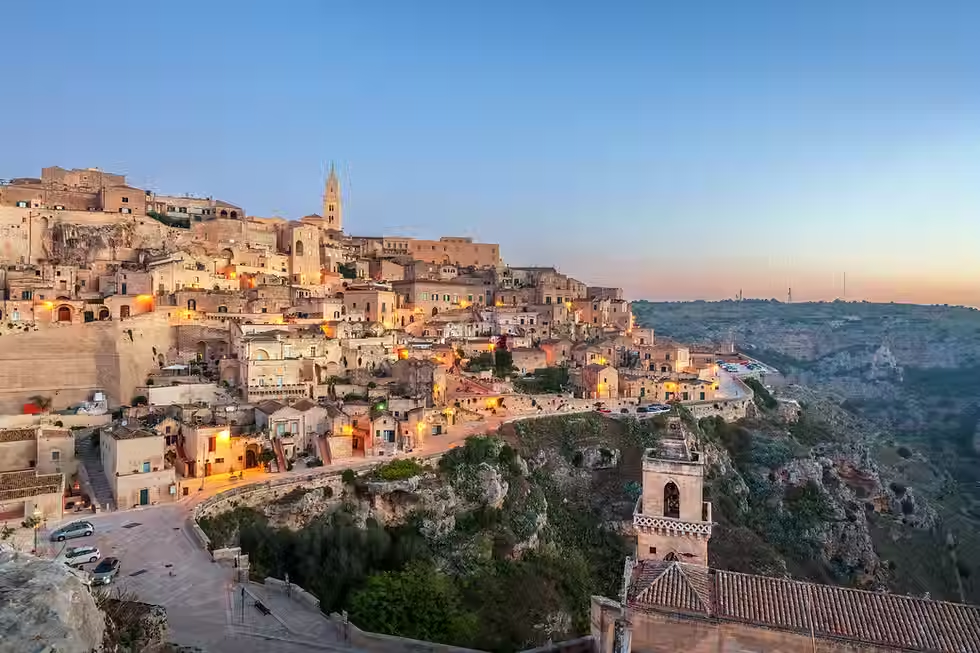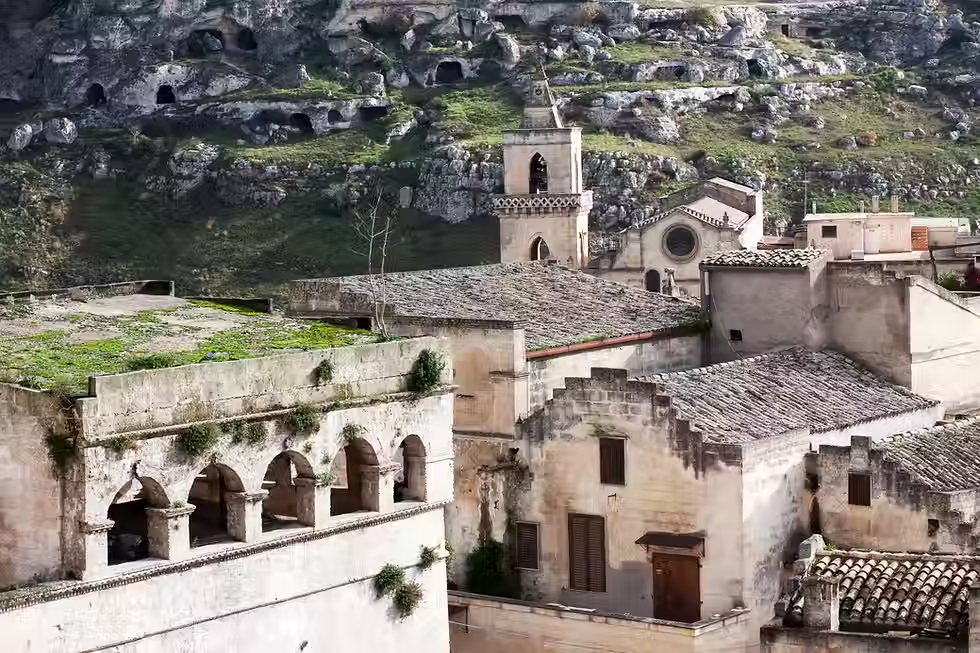What to Do and See in Matera: Italy’s Ancient Cave City Brought Back to Life
- Giada Jannotti
- May 26
- 6 min read
Updated: Oct 20

At first glance, Matera doesn’t look real. Just as the sun rises, it washes over a tangle of limestone dwellings that appear to have emerged from the earth, like fossils of a forgotten civilization. But this isn’t a ruin or a film set. This is one of the oldest continuously inhabited cities in the world, and today, it’s stirring from centuries of silence.
Once called “the shame of Italy,” Matera has risen from obscurity to become a UNESCO World Heritage Site and European Capital of Culture. Yet beyond the accolades and Instagram posts, the city holds something deeper: a quiet endurance, a story chiseled in stone.
Where is Matera?
Many people associate Matera with Puglia (as it sits right near the border), but Matera belongs to Basilicata, one of Italy’s least-known regions. Perched on a plateau above a steep ravine, it lies about 75km (1 hour car drive) from Bari, the closest airport and major city.
However, this geographical confusion works in Matera’s favor! It has remained a secret for decades, shielded from the well-trodden circuits of southern Italy. And that’s precisely its magic. Matera offers a raw, elemental experience of place, a geography not polished for mass tourism, but grounded in authenticity.
A Very Brief History of Matera
Matera’s story begins in prehistoric times, long before Rome rose or Greece flourished. The area of the Murgia plateau has been inhabited since the Paleolithic era, and the Sassi districts are considered among the earliest human settlements in Italy, an unbroken thread of life stretching back over 9,000 years.
The city evolved through Greek, Roman, Lombard, and Norman rule, shaped not by grand monuments but by the rhythm of survival. Matera was never a seat of empires; it was a city of farmers, shepherds, and monks. Its churches were hewn from the rock, its homes carved into canyon walls, and its people lived in profound connection with the land.
By the 20th century, Matera became a symbol of extreme poverty. Families lived in dark, damp caves without water or electricity. In 1952, this led to a mass relocation and decades of abandonment. But Matera endured. And in a twist of fate, what once marked it as backward is now what makes it extraordinary: a city reborn through the very stones that sheltered it.



Matera and The Sassi
Matera is best known for its Sassi (stones): two ancient districts carved into the soft limestone of the city’s canyon walls. These cave dwellings date back over 9,000 years, evolving from prehistoric shelters to complex homes, chapels, cisterns, and communal spaces.
Walking through the Sassi is like slipping through the folds of time. Doors open into dim, cool rooms where families once lived alongside their animals. Churches emerge suddenly from the rock, their facades barely distinguishable from the cliffside. At every turn, erosion and ingenuity meet in surreal harmony.
Highlights include:
Casa Grotta di Vico Solitario – a restored cave dwelling with furnishings preserved from the 1950s
Santa Lucia alle Malve – a rupestrian church with 13th-century frescoes
Palombaro Lungo – an immense underground water cistern beneath the main square, revealing Matera’s ancient water-harvesting techniques
Church of San Pietro Caveoso - a beautiful church that appears among the Sassi

Where To Stay in Matera
Matera is full of beautiful options, but one of the best suggestions is not to stick to a hotel chain, as you will definitely miss the whole point of the city and its essence. Go for traditional accommodations that highlight the beauty of the city with rooms carved in stone that boast all comforts, and yes, also a view of the city.
One of the most beautiful times of day in Matera is either dawn or sunset... so why not choose a place with a beautiful panoramic terrace to take it all in? Rural Escapes suggests L'Antica Conceria, a beautifully restored boutique accommodation with uniquely designed rooms, a grand panoramic terrace, and a breakfast area with a view of the city.
Best Things To Do in Matera
Beyond the Sassi, Matera offers layers of discovery:
Belvedere Murgia Timone: For the most iconic view of the city, cross the Gravina River to this lookout point. At sunrise or sunset, the city glows like a lantern lit from within.
MUSMA (Museum of Contemporary Sculpture): A fascinating blend of ancient and modern art, housed inside a system of caves.
Civic Museums & Palazzo Lanfranchi: Offering context into Matera’s troubled yet poetic evolution.
Want a deeper immersion? Hike the trails that wind through the Parco della Murgia Materana, a wild plateau dotted with Neolithic cave churches and grazing sheep.
Best Restaurants in Matera
Matera’s cuisine is soulful and elemental, like its architecture. Expect slow-cooked lamb, wild chicory, Senise peppers, and peasant breads baked in ancient wood-fired ovens.
Recommended places to dine:
Baccanti Ristorante: elegant and high-end, yet grounded with Materan classics like cavatelli with lamb ragù, served inside a vaulted cave.
Basquiat: Authentic, cozy, and serving typical regional dishes
Vitantonio Lombardo Ristorante: Michelin-starred innovation with deep local roots: amazing dishes served in original, sculptured plates. Not just a restaurant, this is the ultimate palate experience.
Pietra Viva: Seasonal dishes and handmade pasta are the main highlight (and don't forget to try their ravioli)!
It is highly recommended to book in advance via phone as many restaurants don't have websites for direct reservations.
Don’t miss the Pane di Matera, a rustic bread with a protected designation (IGP), baked to an ancient rhythm that honors the community ovens of the past.

Need help planning your trip to Italy?
Book a free consultation with a member of our team of local experts and get a head start!
Beyond Matera: Nearby Places and Things To See
Here is a list of the top nearby locations to visit when you're staying in Matera:
Alberobello (Puglia): one of the most unique towns in the world with its fairytale-like houses
Altamura (Basilicata): famous for its bread, Pane di Altamura (crunchy and great with fillings) - don't forget to visit the oldest bakery of Altamura, Antico Forno di Santa Caterina, for the best bread in town!
Polignano a Mare (Puglia): dramatically built into limestone cliffs, this town enchants travelers and locals with its sea caves, cliff-diving views, and poetic charm (home to the famous restaurant Grotta Palazzese).
Craco (Basilicata): a hauntingly beautiful ghost town perched on a hilltop, Craco offers a cinematic glimpse into Italy's abandoned past.
Bari (Puglia): a city that pulses with southern soul, where labyrinthine old town streets meet a lively seafront and unbeatable street food.
Monopoli (Puglia): a whitewashed fishing town with a still-working harbor that blends authenticity, Baroque churches, and Adriatic breezes.
Matera is not a place you merely visit, it’s a place that rewires your sense of time. To walk its stone alleys is to brush against the bones of an old world still whispering beneath the modern one. It humbles and surprises, reminding you that sometimes the most extraordinary destinations aren’t invented, they’re uncovered.
Useful Things to Know Before You Go to Matera
How is the weather in Matera?
Matera is beautiful year-round, but spring (April–June) and early autumn (September–October) are ideal. These shoulder seasons bring mild temperatures and golden light that flatter the stone architecture.
Summer (July–August): Hot (often 30–35°C), but dry. Early mornings and evenings are best for exploration.
Winter (December–February): Quiet and contemplative, with occasional frost lending an unexpected magic to the cave city.
How to get to Matera?
Though it feels remote, Matera is accessible via multiple routes:
By Air: The nearest airport is Bari Karol Wojtyła (BRI). From there, it's a 1-hour 15-minute drive or regional train ride.
By Train: From Bari, take the Ferrovie Appulo Lucane (FAL) to Matera Centrale. Note: these are local trains and require separate tickets from Trenitalia.
By Car: Driving is highly recommended if you plan to explore nearby gems like Craco (the ghost town) or the Lucanian Dolomites.
When is the best time to visit Matera?
The summer is the best time to visit Matera. Why? Not a lot of tourists go there during the summer because they think it is overcrowded... actually, all Italians go away for the holiday, and the city streets remain free to roam.
What are the top attractions in Matera?
The best things to see in Matera include: Sassi districts, Palombaro Lungo, Murgia Park, rock churches, and Belvedere viewpoints.
How do I get to Matera from Bari?
The best way to get to Matera is by car (1h 15m) or by taking the regional train to Matera Centrale (approx. 90 minutes).
Rural Escapes also offers a private transfer for travelers seeking comfort and no long waits or surprises (especially during the summer, Italian regional trains to get really warm).
How can I book a stay in Matera?
To book a stay in Matera's heart, contact us and we'll be happy to help you plan your trip!
.png)














